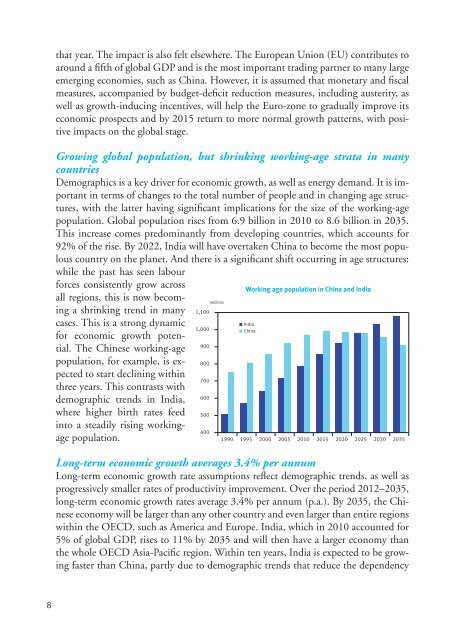World Oil Outlook - Opec
World Oil Outlook - Opec
World Oil Outlook - Opec
- TAGS
- world
- outlook
- opec
- www.opec.org
Create successful ePaper yourself
Turn your PDF publications into a flip-book with our unique Google optimized e-Paper software.
e 6.3<br />
6.1<br />
8<br />
that year. The impact is also felt elsewhere. The Additional European requirements to Union 2016 (EU) contributes to<br />
20<br />
Projects to 2016<br />
around a fifth of global GDP and is the most important trading partner to many large<br />
emerging economies, such as China. However, 15 it is assumed that monetary and fiscal<br />
measures, accompanied by budget-deficit reduction measures, including austerity, as<br />
well as growth-inducing incentives, will 10 help the Euro-zone to gradually improve its<br />
economic prospects and by 2015 return to more normal growth patterns, with posi-<br />
5<br />
tive impacts on the global stage.<br />
Growing global population, but shrinking working-age strata in many<br />
countries<br />
Demographics is a key driver for economic growth, as well as energy demand. It is important<br />
in terms of changes to the total number of people and in changing age structures,<br />
with the latter having significant implications for the size of the working-age<br />
population. Global population rises from 6.9 billion in 2010 to 8.6 billion in 2035.<br />
This increase comes predominantly from developing countries, which accounts for<br />
92% of the rise. By 2022, India will have overtaken China to become the most populous<br />
country on the planet. And there is a significant shift occurring in age structures:<br />
while the past has seen labour<br />
forces consistently grow across<br />
all regions, this is now becoming<br />
a shrinking trend in many<br />
cases. This is a strong dynamic<br />
for economic growth potential.<br />
The Chinese working-age<br />
population, for example, is expected<br />
to start declining within<br />
three years. This contrasts with<br />
demographic trends in India,<br />
where higher birth rates feed<br />
into a steadily rising workingage<br />
population.<br />
1,000<br />
900<br />
800<br />
700<br />
600<br />
500<br />
400<br />
25<br />
0<br />
millions<br />
1,100<br />
mb/d<br />
Additional requirements to 2035<br />
Crude distillation Conversion Octane units Desulphurization<br />
Working age population in China and India<br />
1990 1995 2000 2005 2010 2015 2020 2025 2030 2035<br />
Long-term economic growth averages 3.4% per annum<br />
Long-term economic growth rate assumptions reflect demographic trends, as well as<br />
progressively smaller rates of productivity improvement. Over the period 2012–2035,<br />
long-term economic growth rates average 3.4% per annum (p.a.). By 2035, the Chinese<br />
economy will be larger than any other country and even larger than entire regions<br />
within the OECD, such as America and Europe. India, which in 2010 accounted for<br />
5% of global GDP, rises to 11% by 2035 and will then have a larger economy than<br />
the whole OECD Asia-Pacific region. Within ten years, India is expected to be growing<br />
faster than China, partly due to demographic trends that reduce the dependency<br />
India<br />
China<br />
Global capacity requirements bry process type<br />
2011–20235<br />
<strong>World</strong> supply of primary energy by fuel type<br />
mboe/d<br />
400<br />
Nuclear/Hydro/Biomass/Other renewables<br />
350<br />
Gas<br />
Coal<br />
<strong>Oil</strong><br />
300
















